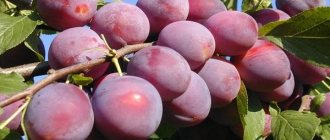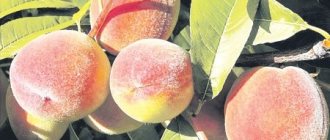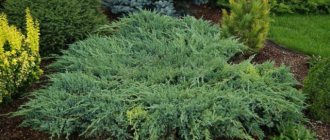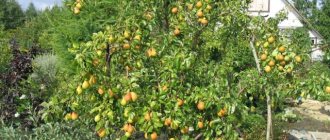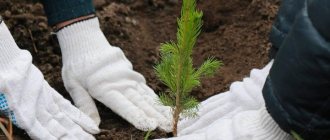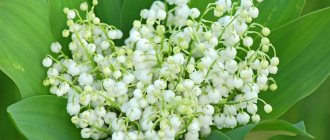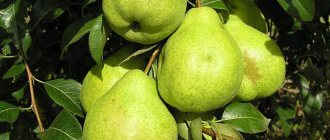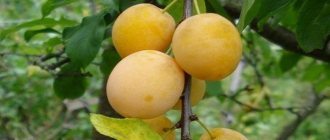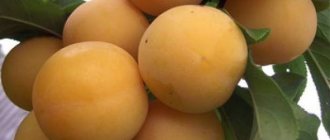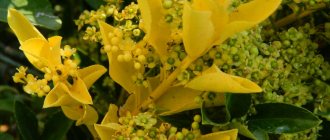Author: Natalya Category: Fruit and berry plants Published: June 25, 2016Republished: February 26, 2019Last edits: November 2, 2020
- Spring care
- When to prune
- Reproduction methods
- Varieties for the Moscow region
Cherry plum (lat. Prunus cerasifera), or spreading plum, or cherry plum, is a species of the genus Plum of the Rosaceae family, a woody fruit plant, which is one of the original forms of domestic plum. The word cherry plum comes from the Azerbaijani language and means “small plum”. The plant itself is native to Western Asia and Transcaucasia; cherry plum can also be found in the wild in the south of Ukraine, Moldova, the Tien Shan, the Balkans, Iran and the North Caucasus. It is cultivated in Russia, Ukraine, Western Europe and Asia.
Planting and caring for cherry plum
- Planting: in cold areas - in spring, in warm areas it is better to plant in autumn.
- Flowering: early May.
- Lighting: bright sunlight.
- Soil: fertile loam.
- Watering: on average - three times per season: after flowering, after shoot growth stops and after the fruits acquire the required color. Water consumption is 1.5-2 buckets for each year of the tree’s life. Young plants are watered 4-5 times per season. In October, if the autumn is dry, water-recharging irrigation is carried out.
- Top dressing: once every 2-3 years, apply 10 kg of organic matter per 1 m² of tree trunk circle. Mineral fertilizing is needed annually: nitrogen fertilizing is applied before flowering, and phosphorus and potassium fertilizing is applied in June. Twice a season, foliar feeding is carried out: in May - with a solution of microelements, in June - with the same solution, but with the addition of potassium and phosphorus fertilizer.
- Pruning: sanitary and formative is carried out in the spring, before the buds open. If absolutely necessary, corrective pruning can be done in the summer.
- Reproduction: by root suckers, grafting, cuttings, sometimes by seeds.
- Pests: brown fruit mites, slimy and yellow plum sawflies, oriental and plum moths, aphids, subbark leafrollers.
- Diseases: Hole spot (klyasterosporiosis), milky sheen and false milky sheen, moniliosis (gray mold), marsupial disease (plum pockets), coccomycosis.
Read more about growing cherry plum below.
Choosing a site for planting in the spring
Cherry plum by nature is a heat-loving tree, so an open sunny area protected from cold winds is chosen for it, preferably on a sloping slope with a western, northern or northwestern exposure. Trees growing on the south side of buildings that protect them from the wind are characterized by high yields and larger fruits.
The best soil for cherry plum is fertile loam. The tree does not like excessively wet soils. The root system of cherry plum is mainly located at a depth of 30-40 centimeters, so it can be planted in areas with groundwater at a depth of at least 1 meter.
Botanical description
Cherry plum is a branched multi-stemmed tree or shrub from 1.5 to 10 m high with powerful roots and thin brownish-green shoots. The leaves of cherry plum are elliptical in shape, pointed towards the top. Single flowers with a diameter of 20-40 cm, white or pink, bloom in early May - a blooming cherry plum is practically indistinguishable in appearance from a blooming plum. The fruit of the cherry plum is juicy, round, sometimes flattened, sometimes elongated drupes up to 3 cm in diameter, yellow, green, red, pink, purple or almost black, covered with a light waxy coating. The stone is elongated or round, convex or flat, and is often difficult to separate from the pulp. Its core contains oil that is not inferior in quality to almond oil. The fruits ripen, depending on the variety, from July to September. The lifespan of cherry plum is 30-50 years.
Most of the varieties and hybrids of cherry plum are self-sterile, that is, in order for the cherry plum to bear fruit, you need to have not one, but at least two trees on the plot, blooming at approximately the same time. And even if you have a self-fertile cherry plum variety, if there is another cherry plum tree nearby, the fruiting will be more stable and more abundant.
Cherry plum is a relative of such crops as plum, apricot, peach, almond, apple, pear, rose hip, hawthorn, medlar, serviceberry, cotoneaster, quince, rowan and chokeberry. Cherry plum is a flexible, unpretentious crop, and yet it is not as popular among amateur gardeners as many of its relatives. Previously, cherry plum was grown only in warm areas, but thanks to the work of breeders who crossed cherry plum with Chinese plum, a hybrid appeared, endowed with higher winter hardiness - Russian plum, or hybrid cherry plum. This hybrid is consistently productive, it begins to bear fruit 2-3 years earlier than cherry plum, is resistant to diseases and pests and is drought-resistant.
- Volzhanka: planting and care
We will tell you how to grow cherry plum in your garden, how to feed the cherry plum to stimulate its abundant fruiting, how to treat cherry plum from diseases and pests, how to graft cherry plum onto a plum rootstock and give you a lot of other information that will help you navigate this issue well, like planting and caring for cherry plum.
Gardeners to gardeners
Today we want to introduce you to a new and truly unique crop - columnar cherry plum, which not many amateur gardeners know about yet.
The columnar cherry plum was bred at the Crimean experimental breeding station of the All-Russian Research Institute of Plant Growing named after. N.I. Vavilov by breeders under the leadership of Academician of the Russian Academy of Sciences, Doctor of Agricultural Sciences. Sciences, Professor G.V. Eremina and in 2002 included in the State Register of Breeding Tests for the North Caucasus (6) region as a cherry plum variety.
It is a seedling obtained from free pollination of the Hiowata cherry plum with the common cherry plum.
The use of frost-resistant rootstocks has made it possible to significantly increase the frost resistance of the columnar cherry plum itself (up to – 32 degrees), which makes it possible for Russian gardeners to grow it in the northern regions of the country.
This culture is quite unpretentious, takes root well in a new place and after three years immediately begins to produce very high yields. Today we will tell you about how to properly plant and grow columnar cherry plum on your site.
SOME FEATURES OF COLUMNARY CHERRY-CHRUM
Columnar cherry plum is a small tree, 2.5 - 3 m high, with a sparse crown consisting of several thick branches growing vertically upward and almost pressed against the central trunk.
The crown diameter of such a tree is no more than 1.5 m, which makes it possible to use not much space on the site for its cultivation.
The leaves of columnar cherry plum are elongated, dark green with jagged edges. The fruits are quite large (weighing up to 55 g) and broadly ovoid in shape. The main color is golden-orange, the outer color is burgundy-violet.
The skin of the fruit, although thin, is very durable with a medium waxy coating. The pulp is soft pink, very juicy and sweet with a delicious strawberry-apricot aroma. Of all the varieties of cherry plum and Russian plum, the columnar one is perhaps the most delicious.
The fruits of columnar cherry plum are rich in vitamins and nutrients. They contain: vitamins – A, almost the entire group B, C, D, E, K, P, PP; organomineral acids, glucose, fructose, various low-calorie sugars, carotene, pectins, trace elements - potassium, phosphorus, calcium, magnesium, sodium, silicon, iron, manganese, copper, zinc, selenium, antioxidants, natural antibiotics.
The productivity of columnar cherry plum is very high (up to 40 kg per plant). The tree is literally completely covered with elegant, bright fruits that appear both on the trunk and on the branches.
The harvest ripens in early August and can remain on the branches for quite a long time without falling off.
Columnar cherry plum is never affected by pests. Most likely this is due to the fact that its dormant period is quite long, and it blooms later than all varieties of cherry plum and Russian plum. At the same time, the development phases of plants and insects do not coincide. By the way, she gets sick extremely rarely.
This allows you to get environmentally friendly fruits, since you do not need to treat the trees with chemicals harmful to the body.
In addition, with late flowering, the tree painlessly passes spring frosts, and almost all the flowers set fruit.
If you decide to plant columnar cherry plum on your site, keep in mind that this crop is self-sterile, so you need to plant at least two (or better yet, three) plants nearby for cross-pollination.
Columnar cherry plum easily tolerates winter frosts down to -32 degrees. And drought is not scary for her. The fact is that its branched root system with a powerful taproot easily penetrates the lower layers of the soil and can easily receive nutrients and water from there.
The culture is not afraid of cold winds and drafts, so gardeners often use it to create hedges. And today, on an industrial scale, in more southern regions, forest protection belts are being created from columnar cherry plum.
Columnar cherry plum is also distinguished by its high shelf life and good transportability of fruits. They can be stored in the cellar for more than three months, remaining fresh and aromatic. This is facilitated by a strong, elastic skin with a reliable waxy coating.
Columnar cherry plum is also good for processing. Its fruits produce: delicious preserves and jams, compotes, juices and wine.
COLUMNARY CHERRY-CHRUM: PLANTING AND CARE
In order for the columnar cherry plum to take root well on your site, grow quickly and bring high yields, you need to plant it correctly.
Choosing a landing site . This is one of the most important points when growing columnar cherry plum. The fact is that it needs a lot of sun to form a large harvest of large fruits. Therefore, find her the most well-lit place throughout the day.
It is best to plant columnar cherry plum on a southern or southwestern slope, which has a good outflow of rain and melt water from the tree trunks.
If your site is located in a low place or the groundwater on it comes close to the surface of the earth, then trees will not grow there. In this case, plant them on a hill 45–50 cm high and 1.3 m in diameter.
Soils. Columnar cherry plum loves light, loose, fertile, organic-rich, neutral soils. The crop will not be able to grow on heavy and acidic soils. These must first be neutralized with dolomite flour or crushed chalk (2 kg per 5 sq. m).
On clay, all the soil is removed from the planting holes and filled with artificially prepared soil composed of the top fertile layer, rotted manure (or compost), leaf soil and sand in equal quantities.
Landing dates . Columnar cherry plum tolerates both autumn and spring planting well, especially if the seedlings with ZKS are the ones we have prepared for you.
Optimal planting dates: in spring - from April 18 to May 9; in autumn - from August 25 to October 10.
We recommend that you focus on the climate of your region. Plan your planting so that the seedlings have time to take root. For this they need at least a month
Landing . Dig planting holes two days before planting so that the soil in them has time to settle. Make them 50 cm deep and 60 cm in diameter. Lay drainage made of crushed stone or broken brick in a 10 cm layer at the bottom of the holes and fill them a third with the soil you prepared so that it subsides a little.
Before planting, drive a 1.8 m long planting stake into the center of each hole, to which immediately after planting tie the seedlings with a soft rope in the shape of a figure eight. This will protect still weak plants from breaking in strong winds or snowfall.
Water all the seedlings well with warm water (two watering cans for each), and mulch the tree trunk circles with peat chips or straw in a layer of 5–6 cm.
When planting, make sure that the root collar of the columnar cherry plum remains strictly at ground level.
Fertilizer . You need to pay it three times per season. The first time - in the spring, when the snow has melted, give the plants a urea solution (2 tablespoons per bucket of warm water for each).
Feed the columnar cherry plum a second time with liquid manure (at a concentration of 1:10) before flowering begins - one bucket for each seedling. Apply fertilizer only after abundant watering. Otherwise, you risk burning the tender roots of the plants.
In the fall, apply some ready-made mineral complex under the columnar cherry plum for autumn feeding of fruit trees and shrubs (such as “Autumn Kemira”). The doses used are indicated on the packaging.
In the third year, when the trees begin to bear fruit, add calcium twice - in May and July, either in the form of a solution of calcium chloride (3 tablespoons per bucket of water), or add a liter jar of eggshells, ground into flour, under each plant.
Columnar cherry plums need calcium for the formation of seeds in the fruit. If the plants don’t have enough of it, all the ovaries will fall off.
Watering . Water the columnar cherry plum twice a month with 3 watering cans for each plant. If the summer is hot, water every week. For mature trees, one watering per month is sufficient. But the watering rate should be at least six watering cans per tree.
Trimming . The columnar shape of the crown of this cherry plum variety is determined at the genetic level, so there is no need to cut it. It is enough to carry out sanitary pruning in the spring, removing all dried, old, weak and frozen branches.
Preparing for winter. For the winter, the tree trunk circles of columnar cherry plum need to be covered. It is best to use dry leaves for this in a layer of 40–50 cm.
Lay a double layer of spruce branches on top, placing the spruce branches “needles up” to protect the trees from various rodents who are not averse to eating tasty, sweet wood.
When severe frost sets in, cover the top of the spruce branches with another layer of dense non-woven material, securing it well at the ends so that the cover does not blow away in the wind.
Even a novice gardener can grow a columnar apple tree, because it is completely unpretentious and does not require such careful care.
If you plant columnar cherry plum this fall, then in the third year you will receive your first rather impressive harvest.
We have specially prepared for you seedlings of columnar cherry plum with ZKS on frost-resistant rootstocks with frost resistance up to -33 degrees, which you can buy from us today!
Planting cherry plum
When to plant
In areas with a warm climate, cherry plum takes root better in the fall than in the spring, and in areas with cold winters, spring planting is more reliable. Buy annual cherry plum seedlings for planting that were grown in your region. Seedlings with an open root system should be planted immediately, but those with roots in a container can wait.
Choose an open sunny area for the cherry plum, protected from cold winds, preferably on a sloping slope with a northern, western or northwestern exposure. Trees growing on the south side of buildings, which protect them from the winds, have higher yields, and the fruits are larger and sweeter. The best soil for cherry plum is fertile loam. Since the root system of cherry plum is located mainly at a depth of 30-40 cm, it can be planted in areas where groundwater lies at a depth of at least 1 m.
Planting in autumn
At the end of September, a week or two before planting, dig a hole 40-60 cm deep and 60 to 100 cm in diameter and fill it 2/3 full with a thoroughly mixed mixture of soil, 15-20 kg of humus and 1 kg of nitrophoska. If the soil on the site is acidic, add dolomite flour, chalk or lime to the soil mixture, and if it is alkaline, then you need to add gypsum to it. In addition, a little peat and sand should be added to clay soil, and a little turf soil to sandy soil. If you are planting several trees, keep a distance of 2-4 m between the holes, depending on the crown of the adult cherry plum variety you are planting.
On the day of planting, form a mound at the bottom of the hole from the remains of the soil mixture, place a seedling on it, the roots of which are first lowered into a clay mash with the addition of Heteroauxin, which stimulates root formation, and then fill the hole with soil so that the root collar of the grafted seedling is at surface level. Self-rooted seedlings can also be planted with the root collar deepened.
After planting, the cherry plum is watered, and when the water is absorbed, the tree trunk circles should be mulched.
How to plant in spring
Cherry plums are planted in the ground in the spring before sap flow begins, so it is better to prepare holes for seedlings and fill them with nutritious soil mixture in the fall.
Pre-planting preparation of seedlings is very important: those whose root system is in a container must be watered abundantly before freeing them from it. For seedlings with an open root system, you need to remove all rotten and dried roots and place them in a bucket of water for a day to swell the roots. Before planting, exposed roots are dipped into a clay mash with root former.
Spring planting of cherry plum is carried out in the same order as autumn.
Landing dates
In autumn, cherry plum takes root better in areas with a warm climate, and for areas with harsh winters, spring planting is more reliable. A tree planted in the fall may not have time to take root before frost. In any case, the thermometer readings should be above zero degrees.
In the middle zone and Moscow region, with a predominant temperate climate and the absence of severe, prolonged frosts, cherry plum can be planted in any of the indicated seasons: both autumn and winter. Even in one climatic zone, it is necessary to take into account accompanying factors: soil composition, topography, temperature conditions of air and soil, location of reservoirs.
It is better to purchase the plant in the fall, when there is a choice of planting material, and plant it in the spring. The purchased seedling can be buried for the winter. Having made a hole up to half a meter deep and laid the tree in it in a southerly direction at an angle, dig it in to the middle of the trunk and sprinkle it with earth on top.
Cherry plum care
Spring care
At the end of March or beginning of April, in case of heavy snowfall in winter, you need to dig grooves in the soil to drain excess melt water. The cherry plum trunk and skeletal branches are cleaned of dead bark and washed with a three percent solution of copper sulfate. In April, sanitary and formative pruning of cherry plums is carried out, digging up the area around it, planting seedlings, applying nitrogen fertilizers, preventive treatment against pests and diseases, removing root shoots and grafting cuttings.
If the winter was without snow and the spring without rain, spring moisture-recharging watering of the trees is carried out. A little later, the cherry plum buds are sprayed with a solution of microelements.
In May, you may have to take measures to protect trees from returning spring frosts. At the same time, the cherry plum is fed with complex mineral fertilizers.
Caring for cherry plum in summer
In summer, cherry plum needs regular watering, after which the soil in the tree trunk circles is loosened to a depth of 8-12 cm, while destroying weeds. Keep in mind that young trees require more moisture than mature trees.
- What you need to know about spring pruning apple trees
Conduct a merciless fight against harmful insects and fungi, pinch the ends of shoots that may not ripen until the end of the growing season.
If a large harvest is expected, take care to install supports in advance. A month after the first foliar feeding, apply a second one, which, in addition to microelements, should contain phosphorus and potassium.
Fruiting cherry plum feeds its fruits in August and lays generative buds for the next year, so it needs your care more than in other summer months. Remove weeds, loosen the soil in tree trunk circles, moisten the soil to the depth of the roots, feed the cherry plum with organic fertilizers - a solution of a bucket of mullein in 7-8 buckets of water or bird droppings in a ratio of 1:20. If there are no organic fertilizers, apply phosphorus-potassium mineral fertilizers.
Autumn care
After picking the berries, at the end of September, when the leaves begin to turn yellow, add organic and mineral fertilizers to the soil for digging. Before the massive leaf fall, carry out pre-winter moisture-recharging watering of the cherry plum to a depth of 40-60 cm. If you plan to plant seedlings, try to do this in the first ten days of October, while the top layer of soil is not yet frozen.
After planting, preparation of the trees for wintering begins: the cherry plum bark is cleared of dead particles, after which you can begin whitewashing the trunks and the bases of skeletal branches with lime. If there are hollows on the trees, they are closed up and the root shoots are removed. Fallen leaves, bark scrapings and other plant debris should be collected and burned.
Cherry plum processing
As a preventive measure, in April, cherry plums are sprayed against pests, fungal, viral and bacterial diseases with a one percent solution of copper or two percent solution of iron sulfate. However, before processing the cherry plum, make sure that the sap flow has not yet begun, otherwise you may burn the opening buds. The same prevention should be carried out in the fall, after leaf fall, in order to destroy pathogenic microorganisms and insect pests that have settled for the winter in cracks in the bark or in the soil of the tree trunk.
Watering
Cherry plum is a drought-resistant plant, but it also needs moisture. On average, in the absence of natural precipitation, adult cherry plum is watered three times during the summer - after flowering, after shoot growth stops and after the fruits acquire the color required for the variety. In October, moisture-recharging watering of cherry plums is carried out before winter. If a dry spring comes after a snowless winter, then you need to water the cherry plum in May. For each adult plant, 1.5-2 buckets of water are consumed in one watering session for each year of life. Young trees are watered more often - 4-5 times per season.
Top dressing
When and how to fertilize cherry plum? Organic matter is added to the cherry tree tree trunk in the fall at the rate of 10 kg per m², but this is done no more than once every 2-3 years. The plant requires mineral fertilizers annually: in the spring, before flowering, nitrogen fertilizers are applied to the tree trunk circle, and in the summer, in June, potassium and phosphorus fertilizers are applied.
The approximate consumption rate of nitrogen fertilizers (urea, for example) is 15-20 g per m², potassium fertilizers (potassium sulfate) are added at 15-25 g/m², and phosphorus fertilizers (superphosphate) are 40-50 g/m². In addition to root fertilizing, foliar fertilizing is carried out twice per season: the first, consisting of a solution of microelements, is carried out in May, the second, of the same composition, in June, but phosphorus and potassium fertilizers are added to it.
Wintering cherry plum
Adult cherry plum overwinters without shelter; young seedlings only need high hilling of the trunk and obligatory mulching of the tree trunk circle with a thick layer of peat, humus or compost. Mulch can also be useful for mature trees. When the snow falls, don’t be too lazy to cover the tree trunks with snow and throw it in a snowdrift in the tree trunk circle - under such cover the cherry plum is not afraid of any frost.
Spring care
In the first year after planting, the trees do not need to be fed , as the fertilizers applied during planting will be enough for them.
Trees older than two years are fed in the spring . Before the tree begins to bloom, add ammonium nitrate (up to 90 grams per m2), at the beginning of summer potassium (up to 50 grams), superphosphate (up to 180 grams).
In early spring, water outlets are made so that the roots do not flood. At the same time, pruning is carried out. Remove dried branches. Thin out the crown, leaving branches that are located at a distance of up to 20 cm from each other . The tops of the branches are pinched.
The old bark is removed and the trunk is treated with a solution of copper sulfate (3%). In April they spray for pests.
If the spring is dry, then water the plant 2-3 times in the spring. .
Pruning cherry plum
When to prune
Professionals and experienced amateurs believe that the best time for pruning cherry plum is spring. Before the buds begin to swell, in March-April, sanitary pruning and formation of cherry plums can be carried out, since at this time there is still no strong sap flow. If you did not have time to do this, and the buds have already begun to open, it is better to postpone the pruning until next spring.
Sometimes cherry plums are pruned in the summer, but this pruning should be minor and corrective.
How to trim
What types of pruning are there? Sanitary, thinning, shaping and rejuvenating. Sanitary pruning is carried out in order to free the tree from unnecessary branches. It can be carried out, if necessary, at any time of the year, except winter. Thinning pruning is usually done in spring or summer to rid the crown of branches and shoots that thicken it and do not allow the sun's rays to penetrate to the ripening fruits located in the thicket.
Formative pruning of the crown promotes good formation and ripening of fruits; in addition, a tree with a properly formed crown is easier to care for, it lives longer and gets sick less often. Rejuvenating pruning of cherry plum will help in time to replace old branches with new ones and thereby prolong the life of the plant.
- Currants: planting and care in autumn, pruning
Spring pruning
Cherry plum can be formed in the form of a tree with a cup-shaped crown and in the form of a bush. It is better to grow cherry plum varieties that are not winter-hardy enough as a bush: the seedling is cut at a height of 15-30 cm from the surface of the site. The 5-6 branches located on the remaining section are shortened to half a meter and, with the help of guy ropes, they are moved to a position as close to horizontal as possible - in this position it is easier to keep them under the snow in winter, and, therefore, they are not at risk of frostbite and a long and painful recovery after winter , so you can count on a good harvest.
The height of the cherry plum trunk can be 40-50 cm - at this height, the lower skeletal branches of the cherry plum are protected by snow in winter. But some gardeners prefer to form a trunk 80-120 cm high, citing the fact that trees with a low trunk, when snowdrifts settle and snow melts, small branches are deformed and broken, and wounds remain on the tree. That is, you will have to decide for yourself what height of bole it is more appropriate to form for the cherry plum tree in your climate.
The best crown shape for cherry plum grown as a tree is sparsely layered. The crown of the cherry plum is formed in the shape of a bowl, like the crown of a plum, leaving 5-7 main branches and cutting the rest into a ring. In the first year, only 3 branches are left above the trunk, located along the trunk at a distance of 15-20 cm from one another, and those that extend from the trunk at an angle of 45-60 º, and form an angle of approximately 120 º between themselves. Over the next couple of years, add new branches with the same characteristics to the existing ones. After 2-3 years, the formation of the crown is completed, and the top of the conductor is cut off flush with the third skeletal branch.
In the spring, at the end of March or beginning of April, in addition to the formation of the crown of young trees, sanitary and thinning pruning of adult plants is carried out - annual branches that thicken the crown are cut into rings, dry and broken shoots and branches are removed. As the cherry plum begins to bear fruit, the growth of its shoots slows down significantly, and you will have less pruning work.
Summer pruning
The branches of cherry plums grow up to one and a half or even two meters in the first two years, so they will have to be shortened to 60-80 cm, but this is best done in the summer, since increased growth of branches begins at the cutting sites. After summer pruning, new fruitful branches will begin to develop from the lateral buds.
How to prune in autumn
In autumn, cherry plums are not pruned, as this greatly weakens the plant before winter. If necessary, you can remove dry and broken shoots after the leaves fall and the tree enters a dormant period. Do not forget to treat cuts of large branches with garden varnish.
Cherry plum: choosing a healthy seedling, planting scheme, care features
10 features that allow you to plant cherry plum and successfully grow it in almost any region:
- Ripens early.
- Completely undemanding to soil composition.
- It bears fruit annually for 30-50 years.
- Early fruiting - the seedling begins to bear fruit in the 2nd year.
- Gives stable generous harvests from 4 years.
- Drought resistant.
- Grows up to 13 m in height.
- Excellent honey plant.
- Shallow root system.
- Easily amenable to decorative molding. From cherry plum you can “sculpt” the most intricate crown shapes.
Cherry plum is less afraid of frost compared to apricots and peaches. Some varieties can withstand frosts down to -35. But cherry plum is characterized by a short period of rest. Therefore, she often suffers from recurrent colds. How to protect a tree from early spring frosts, read in this material.
Most varieties are self-sterile. It is necessary to plant plums of the Skoroplodnaya or Red Ball varieties nearby. Cherry plum is afraid of spring frosts (except for new hybrid varieties). Fruits well only in sunny areas. Without annual pruning, the yield decreases significantly.
Choosing a healthy cherry plum seedling
The younger the plant, the better. Ideally, the same age. The survival rate of 3-4 year olds is very low. Give preference to cherry plum seedlings with a closed root system and modern hybrid varieties of cherry plum.
They have high frost and drought resistance and produce stable yields. The small sucking roots of the cherry plum die very quickly without moisture. Prolonged exposure of roots to the air, and even to the sun and wind, leads to 100% death of the seedling.
Good seedling:
- Same year.
- The root system is closed or in water.
- A new hybrid variety, undemanding to soil and frost-resistant.
- The kidneys are still sleeping.
- The roots are white when cut.
The most important thing after purchase is to deliver the seedling as quickly as possible and plant the cherry plum in the garden. On the way to the dacha, it is advisable to place the roots in a bucket of water .
If it is not possible to plant cherry plum in a permanent place, then the seedling can be buried in the shade by placing the plant at an angle.
Sprinkle the stem of the cherry plum seedling with soil to 1/3 of its length. Abundant watering is required. The cherry plum can also overwinter in the shelter. But in the spring you should not keep the seedling in such conditions for more than two weeks . Cherry plum buds open early, and from this point on there is very little chance of successful cultivation.
Cherry plum needs to be planted in a sunny place
Ideal place for planting cherry plum
This is one of the few fruit trees that can be planted in areas with close groundwater . But cherry plum does not like shade. A place with infertile soil open to the sun's rays is better than black soil in the shade.
- Southern or south-eastern slope.
- Rows should be placed from east to west.
- It is ideal to plant cherry plum in a sunny, draft-free place.
Since it does not tolerate frosts at the end of winter and early spring frosts, it is better to plant cherry plum the spring before the buds open. And cherry plum seedlings purchased in pots (closed root system) will take root even in summer .
How to plant cherry plum
- The distance between plants is 3-3.5 m.
- The diameter of the planting hole is 70 cm, the depth is 50 cm.
- Refill for the planting pit: 15 kg of humus + 100 g of superphosphate + 60 g of potassium salt + 400 g of ash or lime mixed with fertile soil.
- Leave the root collar 3-5 cm above the ground, straighten the roots and cover them with soil mixture, compact them.
- Trim the upper part of the seedling at a height of 20-30 cm.
- Leave a hole around the cherry plum for watering.
- Water generously.
- Mulch the tree trunk circle with sawdust, mown grass, straw or peat. The main thing is to cover the soil and thereby prevent it from drying out.
Cherry plum care
- Weeding.
- Watering.
- Pest control.
- Annual application of fertilizers from the moment of fruiting.
- Spring and summer crown pruning.
Lack of proper care for cherry plum reduces winter hardiness and the number of fruits.
What are the benefits of fruits?
The color of the fruit directly affects the chemical composition. Yellow cherry plum is much sweeter and at the same time contains a large amount of citric acid. And dark varieties are rich in pectins.
Cherry plum seed oil is very similar in composition to almond oil. It is also used in cosmetology and medicine.
Source: https://avgulen.com/kak-posadit-alychu/
Reproduction of cherry plum
Reproduction methods
Some forms of cherry plum reproduce by seeds, but more often they use vegetative methods - propagation by root suckers, cuttings and grafting. Self-rooted seedlings can be propagated by shoots, root or green cuttings, but green cuttings require a special installation that produces fog, so we will not dwell on it, as well as on the seed method.
With the seed propagation method of cherry plum, the varietal characteristics of the parent plant are not preserved in the seedlings. The seed method is also not used for growing rootstocks, since when propagating cherry plums by grafting, it is better to take plum seedlings of such varieties as Renklod Kolkhozny, Volzhskaya Krasavitsa, Eurasia 21, Vengerka Moskovskaya, as well as damson, apricot, felt cherry and sloe seedlings as winter-hardy rootstocks.
Reproduction by shoots
This method is the easiest to implement. The best material is shoots located at a distance from the mother plant, since such offspring have a well-developed root system, unlike those that grow close to a tree or bush. In early spring, dig up the place where the offspring leaves the root of the tree, and cut off the mother root, retreating 15-20 cm along it towards the tree. The cut place on the tree root should be even, and do not forget to treat it with garden varnish before burying .
The dug up shoots, if they are developed, are planted in a permanent place. If the shoot is small and weak, plant it in well-fertilized loose soil for growing, and when it gets stronger and grows, transplant it to the planned place.
Propagation by root cuttings
Root cuttings are harvested in early spring or autumn from the most productive trees. The roots of young trees are dug up at a distance of 70-100 cm from the trunk, for adults - at a distance of 1-1.5 m. Roots 5-15 mm thick are dug up and cuttings about 15 cm long are cut from them. If you are preparing root cuttings in the fall, fold them in a box with sawdust and store until spring at a temperature of 0-2 ºC.
In the spring, at the beginning of May, the cuttings are planted in loose soil so that the upper end is buried 3 cm, and the lower end even deeper. The distance between root segments in a row is kept within 8-10 cm. The planting area is covered with film, and on sunny days also with burlap. The soil is kept slightly moist. After a month, the film can be removed. Seedlings are grown from root cuttings for one to two years before planting in a permanent place.
Cherry plum grafting
To carry out propagation using this method, it is necessary to have a varietal cutting as a scion and a rootstock - the plant on which the grafting will be carried out. Rootstocks can be grown from shoots or from seeds. You already know how to grow seedlings from shoots. You can grow a rootstock from plum or sloe pits by planting them in moist and loose soil at the end of September.
In the spring, the area with the crops is lightly harrowed, and in May seedlings appear, which are watered all summer, and the soil around them is loosened and weeded. The rootstocks from the seed will be ready for grafting in the summer, in July or August of next year, when sap flow is active in the trees.
Scions are cut on the day of grafting from branches 30-40 cm long, not shorter. Grafting is carried out in several ways: in a T-shaped incision, in the butt, using the method of improved copulation, behind the bark and in the spine.
Before budding, the rootstocks are watered to stimulate sap flow, and the trunk is wiped from dust with a damp sponge. All leaves are removed from the scions, leaving only pieces of petioles 5 mm long, after which the bud with such a petiole is cut off with a sharp knife along with a strip of bark about 3 cm long and at least 5 mm wide. On the rootstock, 3-4 cm above the ground level, make a T-shaped cut, carefully bend the bark at the intersection of the short and long cuts and insert a shield (a bud with a strip of bark) under it, after which the bark is pressed tightly to the wood and the grafting site is tied tape or tape so that the bud itself with the remainder of the petiole is not covered.
Most often, budding is used in the butt, since it is easier to perform and always gives a good result. The method of improved copulation is good when the cutting and rootstock are of the same thickness. If the rootstock is thicker than the scion, the methods of grafting the wood and the bark are recommended.
How to plant cherry plum
In most cases, soils in mid-latitudes are highly acidic, so lime must be added. Several seedlings must be planted at once so that they pollinate each other .
This is interesting: Delicate beauty - Persian cyclamen. Home care and cultivation
Although frost-resistant varieties have been bred, cherry plum is a heat-loving tree by nature. Therefore, they are planted on the south side, in places protected from the wind. The plant loves an abundance of light.
The root system of the Russian plum is shallow and located in the upper part of the soil cover. The tree does not like overly moist soils. It even responds to spring flooding. Therefore, it is not recommended to plant in areas close to groundwater.
Disembarkation order:
- dig a hole in depth and around the perimeter up to 70 centimeters ;
- the distance between planting holes is from 2.5 to 3 meters ;
- the soil is well loosened , humus, lime, and mineral fertilizers are added (double superphosphate-500 grams);
- a mound is placed at the bottom of the pit ;
- plant a seedling, lightly shaking the roots ;
- fix a support nearby to which the tree is tied;
- water well , up to 4 buckets of water;
- the tops are trimmed ;
- The soil on top , perhaps with peat.
More winter-hardy seedlings obtained from cuttings. Seedlings in containers can be planted without holes , lightly dug in and sprinkled with soil on top.
Cherry plum diseases and their treatment
The diseases and pests of the cherry plum are the same as those of the plum, its closest relative, and in order to recognize and deal with them in time, you need to know the description of all harmful insects and the symptoms of each disease.
Hole spot, or clasterosporiasis, appears on the leaves of the plant as brown spots with a dark border. The affected tissues fall out, forming holes in the leaves. Small dirty red spots appear on the fruits and deform them. The branches also become covered with reddish spots, under which the bark cracks, and gum begins to emerge from the cracks.
Control measures. Destroy all plant debris and do not leave it under trees for the winter. Treatment of cherry plum: during the phase of coloring the buds, after the end of flowering and again two weeks later, treat the cherry plum with one percent Bordeaux mixture or the drug Hom in accordance with the instructions. If you are dealing with a severe infestation, apply another application three weeks before harvest. As a preventive measure against the disease in the spring, before the buds open, cherry plums are sprayed with a three percent solution of ferrous sulfate. Do not allow the crown to thicken; carry out thinning pruning in a timely manner.
Milky sheen and false milky sheen look like a silvery coating on cherry plum leaves. The false form of the disease and the real milky sheen have different natures: the first disease is a consequence of the cherry plum freezing in winter, and with good care, watering and fertilization, the tree will recover within a year or three. True milky sheen is a fungal disease that penetrates deep into cherry plum wood and causes stem rot. By mid-summer the leaves turn brown and the cherry plum dries out.
Control measures. In the fight against a fungal disease, the affected cherry plum branch must be immediately removed and destroyed; the cut is treated with a one percent solution of copper sulfate, and then with garden varnish. For preventive purposes, spring and autumn spraying of cherry plums with copper-containing preparations is carried out, all cuts and cuts are treated with garden varnish, and the tree trunk and skeletal branches are treated with lime.
Moniliosis, or gray rot, covers the surface of the fruit with gray pads containing fungal spores. Shoots and branches turn brown and wither, as if they were burned by something, and growths form on the bark.
Control measures. Healthy fruits become infected with moniliosis from sick fruits hanging on the same branch, so diseased fruits must be immediately picked off and burned, as well as shoots affected by gray rot. Before the buds begin to open, treat the cherry plums with a three percent Bordeaux mixture, and before the flowers open and immediately after flowering, treat them with Bordeaux mixture substitutes of the same effect.
Marsupial disease, or plum pockets, is a fungal disease in which the seeds in the fruits do not form, and the fruits themselves grow, become deformed and become covered with a powdery coating. The flesh of diseased fruits is wrinkled and greenish. Affected shoots become twisted and swollen.
Control measures. Diseased cherry plum shoots and fruits are removed and burned. For preventive purposes, cherry plum is treated as against moniliosis.
Coccomycosis appears in early summer as small reddish-brown spots on the upper side of the leaves, which merge with each other as the disease progresses. A powdery pinkish coating appears on the underside of the leaves. The leaves turn yellow and fall off prematurely, the fruits stop developing and dry out.
Control measures. Collect and destroy fallen leaves and fruits. In early spring, before the sap begins to flow, and in the fall after leaf fall, treat the cherry plum and the tree trunk with Hom or one percent Bordeaux mixture.
Cherry plum pests and their control
Most often, cherry plums are affected by the following pests from the insect world:
Brown fruit mite - due to its activity, cherry plum leaves turn brown and fall off, and the process of bud formation for the future harvest slows down.
Control measures. Clean the cherry plum trunk from dead bark before the buds swell; during swelling and during budding, treat the tree with Karate or Fufanon.
The slimy sawfly eats the leaves, leaving only the veins.
Control measures. Collect cherry plums from the site in the fall and destroy plant remains. In July or early August, when the sawfly larvae hatch, treat the cherry plum with Fufanon or Novaktion.
Yellow plum sawfly - the caterpillars of this pest eat the pulp of the fruit and eat the pit. Young larvae damage the ovaries.
Control measures. Adult sawflies need to be collected by hand or shaken off the tree onto a linen sheet. Before and after flowering, spray the tree with Fufanon or Novaktion.
The eastern codling moth gnaws holes in a young shoot, and when it reaches woody areas, it moves to another shoot. Damaged shoots dry out and break. The caterpillars also damage the pulp of the fruit.
Control measures. Trees immediately after flowering and after harvesting are treated with a solution of 500-700 g of table salt in 10 liters of water. To process an adult tree you will need approximately 7 liters of brine, to process a young tree - 1.5-2 liters.
The plum moth penetrates the fruit, covering the entrance hole with a web containing pieces of pulp. The caterpillar eats the pulp of young fruits and the soft stone; in mature fruits, it does not damage the stone, limiting itself to eating the pulp and filling its passages with excrement. The fruits in which the plum moth caterpillar lives turn purple and quickly fall off.
Control measures. Destroy fallen leaves and fruits, clean the cherry plum from dead bark, and treat the cherry plum with insecticides.
Plum aphids feed on the cell sap of leaves and young shoots of cherry plums, as a result the leaves curl, turn yellow and fall off. The tops of the shoots also dry out.
Control measures. At the stage of exposing the buds, the trees are sprayed with insecticides - Karbofos or Sumition, for example. When processing, the composition must be applied to the underside of the leaves.
The subcortical leaf roller gnaws holes in the wood, and this can kill not only individual branches, but the entire tree.
Control measures. Damaged shoots are cut and burned, the sections are treated with garden varnish.
Protection from pests and diseases
In spring before the buds swell
- We cut out dry, diseased branches damaged by bark beetles (if the damage is severe, the branches dry out) and scale insects (on damaged branches you can find barely visible brown-gray shields up to 3 mm long).
- We spray the trees and the soil under them with a solution of urea (700 g per 10 liters of water) or ammonium nitrate (1 kg per 10 liters of water).
- To destroy fungal infections, mosses and lichens, once every 4 years we spray the trees with iron sulfate (300 g per 10 liters of water).
Beginning of bud burst (green cone phase)
- To destroy the causative agents of clasterosporiasis and moniliosis, we spray the trees with 3% Bordeaux mixture.
- For prophylaxis against plum pollinated aphids, you can use one of the following insecticides: novaction (13 ml per 10 liters of water), fufanon (10 ml), sumithion (10 - 24 ml). You can also use a decoction of a mixture of onion peels and garlic cloves or an infusion of chamomile leaves and inflorescences instead.
Protrusion of buds (white bud phase)
- Against sucking and leaf-eating pests (mites, aphids), trees can be sprayed with one of the following insecticides: Novaktion, MKS, Fufanon, Karate, Karate Zeon. Instead, you can also use a decoction of yarrow, an infusion of leaves and inflorescences of chamomile, garlic or onions.
- If trees were damaged by clasterosporiasis or monilial burn in the previous year, they can be treated with azophos (100 g per 10 liters of water) or a 1% solution of Bordeaux mixture.
Isolation of buds
- If the number of plum sawfly is high in the previous year, we treat the trees with Fufanon or Novaktion.
End of flowering
- In cases of severe infection with clasterosporiosis or monilial burn, we treat the trees with a 1% solution of Bordeaux mixture.
- If there is a high number of sawflies and leaf-eating pests, as well as aphids, we treat them with Novaktion and Fufanon.
Fruit ripening
- We cut out drying branches affected by monilial burn.
- We treat wounds (if any) that may appear as a result of damage by bark beetles.
- When wormy carrion affected by the plum codling moth appears, we put catching belts made of burlap, wrapping paper, and corrugated cardboard on the trunks (they should be removed and burned immediately after harvesting).
After harvest
- When the slimy sawfly appears en masse, we spray the trees with Novaktion and Fufanon.
After leaf fall
- We rake and remove fallen leaves from the garden (they can be burned or buried in the ground), in which many overwintering pests and pathogens of clasterosporiosis, coccomycosis and other spots accumulate.
- To destroy wintering sawflies and weevils, we dig up the soil in the tree trunk circles.
Pruning cherry plum
If a seedling is grown in the form of a tree, then in the first 3-4 years we form a sparsely tiered crown. We lay the main branches (4-5 pieces) at a height of 70-80 cm from the ground.
It is impossible to perform severe pruning of cherry plum seedlings, as this stimulates the growth of shoots, thickening of the crown and a decrease in yield. Fruit-bearing trees just need to be thinned out and damaged and diseased branches removed.
The plant can also be formed into a bush, in which case pruning the cherry plum will consist only of thinning the crown and shortening shoots that are growing too rapidly, and care will be greatly simplified.
Grafting cherry plum onto plum
We graft cherry plum onto a young plum tree (no older than 5 years). It is best to do this at the end of March - at the beginning of April, when active sap flow is just beginning in the trees, and the buds have not yet had time to bloom.
The most suitable vaccination methods are the following:
- Budding - in a T-shaped incision or butt;
- Improved copulation;
- Cleft grafting;
- Vaccination for the bark.
Of the above, the simplest method is the last one, and therefore, in most cases, novice gardeners use this one. We will tell you about it in detail.
Grafting cherry plum by the bark - step-by-step instructions.
- We select a healthy branch on a young tree and cut it down into a stump with a garden saw. Next, we cut off the branches extending from the stem with pruning shears.
- On a scion-cutting that was cut in the fall and stored properly, at an angle of 30 degrees we make an oblique cut about 3-4 cm long.
- We make a split in the middle of the cut (“tongue”), which can significantly increase the chances of survival.
- On the side of the rootstock, carefully cut off the top layer of bark and make a “tongue” of the same size.
- We connect the scion to the scion in such a way that the “tongues” interlock with each other, and the cambial layers of the plants coincide.
- We tie the grafting site with plastic tape, and cover all sections with garden varnish.
If after 12-14 days the scion has not dried out, and during active sap flow the buds on the cuttings have turned green, then we can consider that the grafting was a success. Otherwise, you need to try to re-graft the tree with cuttings with “dormant” buds. But keep in mind that in late spring and summer, the scion’s fusion with the rootstock is much worse.
How to deal with cherry plum
Plum, cherry and cherry plum very often produce root shoots that must be dealt with, otherwise they will take over the entire garden.
How to do it? If you do not need a tree that produces shoots, cut it down, drill several holes in the stump as close as possible to the sap-conducting layer and pour Tornado solution or potassium ammonium nitrate into the holes. Cover the top of the cut with a piece of plastic or film. After 5-7 days, lightly drill out the same holes and fill in the next dose of the drug and repeat the same procedure in another week. When the growth dies, do not rush to uproot the stump; make sure that there are no roots left that the drug that destroys them did not have time to reach.
If you do not want to destroy the tree, you will have to fight the growth. Some gardeners recommend digging up shoots and cutting them off at the point where they depart from the root of the mother plant, but experience suggests that it is better not to do this, because in the place of one shoot cut at a depth, two or three grow. Cut the growth at the level of the surface of the area, and if grass grows in the tree trunk, mow the growth along with the grass. Or grow cherry plum varieties that do not produce shoots.
The soil
Cherry plum does not need any special soil, but it will still feel best on fertile loamy neutral soil. If the soil is acidic, then dolomite flour or chalk should be added here, but if it is alkaline, then gypsum.
The root system of this plant should be at a depth of about 30 cm, and therefore it is best suited to an area where groundwater is located from 1.2 meters and deeper. If the waters are located closer to the surface of the earth, then it is better to grow cherry plum on bulk soil (in a flower bed).
Cherry plum varieties
Cherry plum varieties differ in terms of ripening: early varieties ripen at the end of July or early August, medium-ripening varieties - in mid-August, and late varieties ripen by the end of August or in September. According to the size of trees, varieties are tall, medium-sized and low-growing. According to the method of pollination - self-fertile and self-sterile.
Varieties for the Moscow region
Thanks to interspecific hybridization, heat-loving cherry plum is now successfully grown not only in the Moscow region, but also in cooler areas. The best varieties for the Moscow region are:
- Nesmeyana is a new early frost-resistant self-sterile variety with an easily separated seed. The plant is tall and spreading. The fruits are light red in color with dense fibrous pink flesh and a sweet and sour taste;
- Zlato Scythians is a medium-yielding, self-sterile, very early variety with high winter hardiness. The tree is of medium height, the crown is sparse but spreading. Fruits weighing up to 35 g are yellow in color with juicy, tasty pulp;
- Traveler is an early self-sterile frost-resistant variety with medium-sized fruits weighing up to 27 g, yellow with a red-violet bloom, with orange fine-fibered sweet pulp with a delicate aroma. The advantage of the variety is its stable yield, but the disadvantage is that the seed is poorly separated from the pulp;
- Cleopatra is a self-sterile, frost-resistant late variety of medium growth with a wide-conical crown. The fruits are large - weighing up to 37 g, dark purple with a bluish bloom. The pulp is red, gristly, dense, tasty. The bone is separated in half;
- Mara is a medium-sized, mid-ripening, disease-resistant, winter-hardy variety of Belarusian selection with yellow fruits weighing up to 23 g. The fruit pulp is juicy and sweet.
Early varieties
The most popular varieties of early ripening cherry plum include:
- Found - a productive and stable self-sterile variety of high winter hardiness, resistant to diseases, with red-violet fruits, large or medium size, weighing 31 g, with orange fibrous low-juicy pulp;
- Flint is a self-fertile, drought-resistant variety, almost not affected by diseases, with fruits weighing up to 29 g of dark purple color with a waxy coating and red color with dense, low-juicy pulp with a hard-to-separate stone;
- A gift to St. Petersburg - a self-sterile, consistently productive, winter-hardy variety, distinguished by its ability to quickly recover from mechanical damage. The fruits of plants of this variety are very small, weighing up to 12 g, yellow-orange in color with a faint waxy coating and bright yellow, juicy, fine-fibered pulp with a sweet and sour taste. The pit is difficult to separate from the pulp;
- Yarilo is a very early variety with round, shiny red fruits, medium size, weighing up to 35 g and juicy, dense, yellow pulp of excellent sweet and sour taste with a half-separable stone;
- Monomakh is a productive early-fruiting variety with purple fruits weighing up to 25 g with sweet, juicy, fibrous red pulp and a well-separable stone.
Mid-season
The best varieties of medium ripening include the following:
- Gek is a winter-hardy, consistently productive, self-fertile, medium-growing variety with a thick, flat-rounded crown and large yellow fruits weighing up to 35 g with yellow and dense pulp of a sweet and sour taste. The pit is difficult to separate;
- Sarmatka is a winter-hardy, disease-resistant, self-sterile variety with ovoid purple-red fruits of medium size with yellow pulp of medium density and a sweet and sour taste. The pit is difficult to separate from the pulp;
- Sigma is a highly productive and winter-hardy variety with large yellow fruits weighing up to 35 g. The pulp is yellow, dense, sweet and sour;
- Obilnaya - a highly productive self-sterile variety with fruits weighing up to 40 g of red-violet color with a waxy coating and orange dense medium-fibrous pulp of medium juiciness;
- Llama is a tree with red leaves and large dark crimson fruits weighing up to 40 g with juicy, aromatic dark red pulp with a sweet and sour taste. The stone comes away from the pulp well. The variety is self-sterile, but high-yielding and winter-hardy;
Late varieties
Popular cherry plum varieties that ripen closer to autumn and in September include the following:
- Late Comet is a very winter-hardy and productive variety with dark red fruits weighing up to 30 g with aromatic red pulp with a sweet and sour taste;
- Chuk is a low-growing, self-fertile tree with a compact crown, producing dark burgundy fruits weighing up to 28 g with orange dense, aromatic and juicy pulp with a sweet and sour taste. The bone is difficult to separate from the pulp. The variety is productive and disease resistant;
- Columnar is a winter-hardy hybrid between the large-fruited cherry plum and the Hiawatha cherry plum, characterized by its tall growth and compact crown. The fruits of this hybrid are very large - weighing up to 40 g, dark red with a waxy coating and aromatic, juicy pink pulp of medium density and pleasant taste;
- Melon is a medium-sized self-fertile variety, resistant to diseases and pests, with very large fruits weighing up to 45 g, dark red in color with a waxy coating and yellow, medium-dense sugary pulp of excellent taste with a delicate aroma;
- Golden Autumn is a medium-sized, winter-hardy variety with a spindle-shaped crown and small golden fruits weighing up to 20 g, which do not fall off even after leaf fall. The fruit pulp is yellow, has a pleasant taste with an almond tint.
The following varieties and hybrids of cherry plum have proven themselves well: Apricot, Skoroplodnaya, Peach, Kuban Comet, Globus, Amers, Zhemchuzhina, Stanley, Olenka, Purpurovaya, Violet Dessert, Anastasia, Alyonushka, Lykhny, President, Vision, Lyubimaya Mlieva, Shater, Karminnaya, Vetraz, Nasaloda, Pchelnikovskaya, Seedling Rocket, Krasa Orlovschina, Timiryazevskaya, General, Ariadna, Karminnaya Zhukova, Rubinovaya and others.
